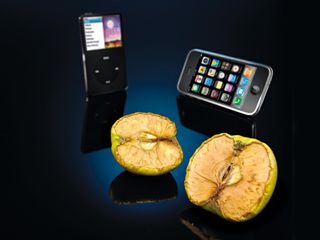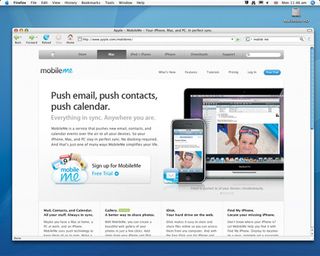
When Steve Jobs speaks, the world listens. His fabled Reality Distortion Field makes even the shiniest piece of chrome and plastic glisten just that little bit more.
The phrase 'One more thing' moves every member of the audience to the very edge of their seats, knowing that whatever follows, they'll soon have one in their possession.
But it wasn't always like this, and even the all-powerful Apple of today sometimes stumbles in mid-stride.
We've gone in search of the biggest flops, missteps and bad ideas that found a half-chewed worm emerging from the apple of our eye.
1. Pippin
Super Nintendo. Master System. Jaguar. Megadrive. Pippin. Can you spot the odd one out?
It sounded like a child's toy, but not many children ever had the chance to play on Apple's ill-fated games console, Pippin. Technologically speaking it was a Mac in a smaller box, intended to play hot CD-based gaming classics like Terror Trax, The Journeyman Project and Mr Potato Head Saves Veggie Valley.
Get daily insight, inspiration and deals in your inbox
Get the hottest deals available in your inbox plus news, reviews, opinion, analysis and more from the TechRadar team.
But whereas most games manufacturers quickly learned the importance of controlling their ecosystem with a vice-like grip, Apple planned to sell the core technology to several different companies – which is ironic in light of the company's current modus operandi.
Unfortunately, like everyone who tried to take on gaming giants Sega and Nintendo, Pippin was a miserable failure. It was an underpowered, undersupported system that reportedly only sold around 5,000 units in the US.
Being a computer, Pippin did have some interesting technology on its side, including innovations like internet access, but without the games to back it up, it was all for nothing. Also, it was called Pippin.
After Pippin crashed and burned, Apple largely gave up on gaming – and most developers still avoid the Mac. However, times have changed. The iPhone's gaming library hasn't defeated the mighty Nintendo, but it's the first thing for a long, long time to pose a really genuine threat to it, if only among casual players.
2. Apple USB Mouse
The infamous 'Hockey Puck' is one of Apple's most mocked inventions, appearing with the launch of the iMac in 1998 and promptly hanging around homes and offices like a bad smell for years to come.

Not only was it ugly, it made pointing and clicking about as much fun as typing on a keyboard covered with needles, using a speech recognition system that insisted you neck a balloon full of helium before every instruction, or anything involving Microsoft Office's 'helpful' paperclip. Not only was its round shape clumsy and uncomfortable, it was far too imprecise when gripped and prone to turning instead of moving.
The cord was far too short if you plugged it into the machine rather than the USB ports on a Mac keyboard, and the buttons weren't very comfortable. Some good did come out of it, though – third-party manufacturers made a fortune selling alternatives and adaptors.
3. MobileMe
Apple had no excuse for MobileMe to flop. The idea was as obvious as it was brilliant – syncing mail, calendars, files and photos between your computer, your iPhone (you did buy one, right?) and the web. So what went wrong? Well, everything.

Not only was it overpriced – and at £50 for a year, remains so – but the original version barely worked. File sharing was missing in action, online storage was too slow and the calendar was a joke compared to Google's offering. As for email, it was fine if you actually wanted to use an Apple-branded address, but with more and more of us switching to personal domains, especially for professional purposes, MobileMe's lack of proper domain mapping really bit down hard.
Even the launch of the service was a big disaster – the pages were slow, the servers were constantly down, the push messaging promised didn't work, and worst of all, a number of trial users found their credit cards charged too early. Apple tried to patch up problems by extending the service's free trials, but there's no doubt that what most who tried it in those early days remember is a horrible experience from a company that makes its money providing the best. Not cool, Apple. Not cool at all.
4. Apple Lisa
Apple kit is too expensive. That's the most common criticism of the company, and it has been right from the start. The Lisa, launched in 1983, was an attempt to go after business customers by offering a more powerful system, higher resolution graphics and support for multitasking and protected memory.

It found a market, particularly in document creation, but the cheap availability of both IBM PCs and standard Macintosh systems worked against it. The Lisa did however offer expansion ports, and a snappy name – although one with no easy explanation. The official version is that it stands for Local Integrated Software Architecture, but nobody believes that.
The standard backronym is Lisa: Invented Stupid Acronym, but most believe it was simply named after Lisa Jobs, Steve's daughter. Jobs worked on the project for a while before jumping ship to work on the Macintosh project.
5. Newton
Pity the poor Newton. Probably Apple's least-deserved flop, this PDA platform (the actual devices were called MessagePad) was truly ahead of its time. It featured integrated handwriting recognition (which worked reasonably, if not completely reliably), was controlled by a touchscreen, and offered lots of applications to make early adopters' lives easier, including notes, contacts and dates.

That's nothing too special by today's standards, but it was an exceptionally powerful device in the early '90s. However, this was only intended to be the start of Newton's capabilities. Apple saw the devices as computers in their own right, and we've yet to truly see a successor that has actually pulled off that massive leap. Perhaps the iPad will be it…
Most Popular
